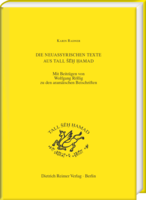|
|
more titles of the subject:
Der Band enthält die Edition von 205 Keilschriftartefakten in neuassyrischer Sprache und Schrift, die in den Jahren von 1982 bis 2000 in Tall Šēḫ Ḥamad, der assyrischen Stadt Dūr-Katlimmu, ausgegraben wurden. Die auf ihnen befindlichen aramäischen Beischriften sind von W. Röllig bearbeitet worden. Das einzige Fragment aus dem Abschnitt Tell/Zitadelle (Nr. 001) ist inzwischen als ein (älterer) Ḫana-Text identifiziert worden (Frahm, N.A.B.U. 2020,1). Alle anderen Tafeln stammen aus den Ausgrabungsabschnitten „Nordost Ecke der Unterstadt II“ und „Mittlere Unterstadt II“, namentlich aus den Ausgrabungsstellen „Neuassyrische Residenzen“ und „Rotes Haus“. Mit ihrer Auffindung waren häufig so genannte „dockets“ in aramäischer Sprache und Schrift vergesellschaftet, die W. Röllig in BATSH 17 editiert hat. Eine vollständige Liste aller in der Ausgrabung registrierten Schriftartefakte aus Neuassyrischer Zeit – einschließlich der nicht publizierten – ist in BATSH 11, 410-423 veröffentlicht. K. Radner hat 14 weitere Keilschriftfragmente, die in den Jahren 2003-2009 ausgegraben wurden, in „Studia Chaburensia“ 1, 2010, 175-186 vorgelegt.
Der größte Teil der Keilschrifttexte sind Kaufverträge aus dem 7. Jahrhundert v.Chr.; einige wenige Exemplare stammen aus älterer Zeit. Eine weitere kleine Textgruppe sind Prozessakten. Im Vergleich zu Zentral-Assyrien sind erstaunlich wenige Schuldscheine in Keilschrift belegt. Dies findet seine Erklärung in den zahlreichen aramäischen Texten, die dieser Gruppe zuzuordnen sind. Das wiederum wirft ein Schlaglicht auf die tatsächlichen Verhältnisse in den westlichen Reichsgebieten, in denen die Bevölkerung aramäisch sprach und die Schreiber die Keilschrift wie die aramäische Buchstabenschrift beherrschten. This volume contains the edition of 205 cuneiform artifacts in Neo-Assyrian language and script excavated in Tall Sheikh Hamad, the Assyrian city of Dūr-Katlimmu, between the years 1982 and 2000, including the Aramaic epigraphs inscribed on some of them edited by W. Röllig. They originate from three different excavation units. The only fragment from the citadel of Dūr-Katlimmu (no. 1) has meanwhile been identified as a Hana text (Frahm, N.A.B.U. 2020,1). All other tablets were excavated in the Lower Town II of the city, in the excavation unit „Northeast Corner of Lower Town II“ and in both excavation sections „Neo-Assyrian Residencies“ and „Red House“ of the excavation unit “Central Lower Town II”. Frequently discovered in context were so called “dockets” in Aramaic language and script which W. Röllig has edited in BATSH 17. A complete list of all the written artifacts of the Neo-Assyrian period registered by excavation number – including the ones not edited – is published in BATSH 11, 410-423. An additional 14 cuneiform texts excavated in the years 2003-2009 were published by K. Radner in “Studia Chaburensia” 1, 2010, 175-186. The vast majority of the cuneiform texts are legal contracts from the 7th century BC, with some earlier examples. Most of these tablets document sale transactions. A number of texts represent lawsuit documents. A surprisingly small amount of debt notes — a group of legal documents which is very well presented in the text material from Central Assyria — has been excavated in Dūr-Katlimmu. As they are replaced by the Aramaic texts (BATSH 17), it is clear that the scribal practice for these documents allowed the use of Aramaic in the western part of the Assyrian empire, reflecting the fact that Aramaic was the language actually spoken there. |






